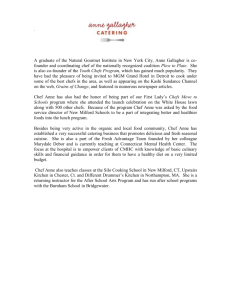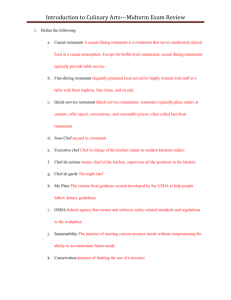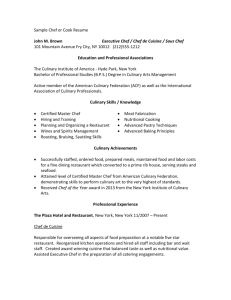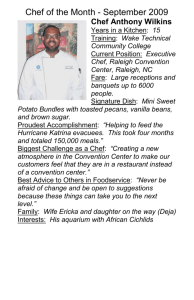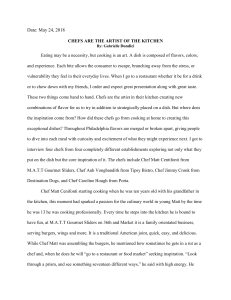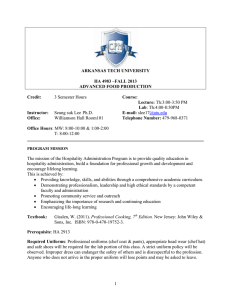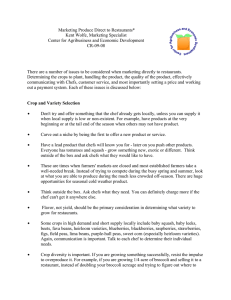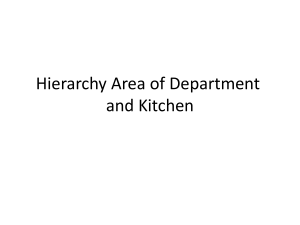History of Modern Food Service: Culinary Arts Presentation
advertisement
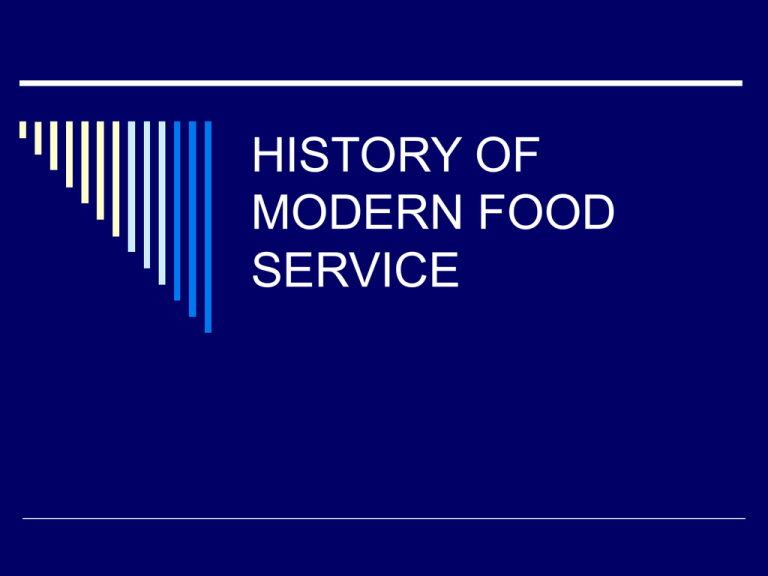
HISTORY OF MODERN FOOD SERVICE CA-ICA-1. Students will examine and identify the history and philosophy of the food service industry. What events and people have influenced the development of the modern What opportunities are available for employment in the hospitality/food service industry FOOD IN ANCIENT GREECE AND ROME 300 BC – 475 AD Greece and Rome – Lavish banquets Marcus Apicius (Rome) wrote the first cookbook De Re Coquinaria (On Cooking) Still used today He wrote of putting meats and sauces on bread (Pizza?) When he had difficult financial times he killed himself for fear of not having good food to eat When Roman Empire fell, so did fine dining and lavish banquets (475 AD) Middle Ages (500 AD – 1100) Feudalism – wealthy landowners with serfs who worked the fields Poor diets – stored root vegetables and salted and smoked meats Wealthy had banquets, but not formal. Ate with hands Purpose – only to eat Trenchers – stale bread used as plates Renaissance (Awakening) (1200 – 1700’s) Wealthy craved spices to flavor foods Marco Polo introduced spices to Europe New ideas about life, art and food Catherine de Medici married Henry II of France She brought fine food, ice cream and use of silverware to French Court Brought Haute Cuisine to France – elegant ways of preparing/serving food Catherine de Medici She was from Italy – had arranged marriage to Henry II 14 years old at time of marriage Brought her chefs with her to France. Was homesick and the marriage was bad. Poured herself into society to keep herself busy No children for 10 years, the 9 children in 11 years!!! Brought fork, ice cream to France Café or Coffehouses open 1650 the first café opened in England Until then, only public places were taverns – open to men only Coffeehouses welcomed women Bakers began to serve pastries Great Chefs in history Marie – Antoine Careme (late 1700’s) King of Chefs and Chef to Kings Art of Grand Cuisine Classified the sauces into 4 groups – system still used today Created sugar sculptures – sweet pieces that are forerunners of wedding cakes Felt bakery pieces were a branch of architecture Boulanger Don’t know his first name! Was private chef to royalty When the French Revolution occurred, he was out of work Opened the first restaurant (Paris) 1765 Served soup Known as the father of the restaurant Chef’s – cont. George Escoffier (1800’s) Simplified Careme’s work – believed fewer ingredients maintained balance and perfection Developed the kitchen brigade system which assigns specific tasks to kitchen staff Established sanitation rules and rules for dress His books are still important references Foodservice in the United States Colonial American did not travel or eat out The Industrial Revolution (1800’s) brought people to the cities Coffee shops and diners (kitchens on wheels) were established Fine dining – Delmonico’s opened in New York. Opened a 2nd – first chain http://www.delmonicosny.com/ Gold Rush in California 1850’s Gold discovered in California People moved west – cafeterias opened to feed people moving west Inexpensive, assembly line dining 1900’s Fast food – White Castle 1st chain After World War II, quick service restaurants such as McDonald’s and KFC Quality, safe, affordable food 1970’s Nouvelle Cuisine “New Cooking” Modern chefs wanted to lighten up classical French cuisine Trend did not last long Classic (French) Organization of a Kitchen (Kitchen Brigade) OH- 12.1 Contemporary Version of Classic Kitchen Organization OH- 12.2 The Executive Chef – Has culinary education and degree Good Knowledge and skills Judge the quality of food Manage and lead May be in the office more than the kitchen Oversees food costs Sous Chef – Management level Second in command – Means Under the Chef Assistant to executive chef Station Chefs Have knowledge and cooking skills May or may not have culinary education Are responsible for food preparation Entry Level Jobs No experience necessary May wash dishes, clean vegetables Culinary Arts Industry Factoids and Forecasts Culinary Arts is a growth industry. Over 70% of eating and drinking establishments are independently owned. Almost half of American adults have worked in the restaurant industry at one time. There were 3.1 million chefs, cooks and food preparation workers in 2006. Average Pay Ranges Job Title Annual Earnings of Middle 50% Cooking Assistant $23,096 - 28,862 Executive Chef $55,976 - 85,328 Executive Pastry Chef $45,610 – 68,326 Food Scientist $48,289 – 73,410 Hotel Manager $64,926 – 119,094 Line cook $19,280 – 25,229 Restaurant Manager $36,778 – 53,916 Sous Chef $31,977 – 49,745

